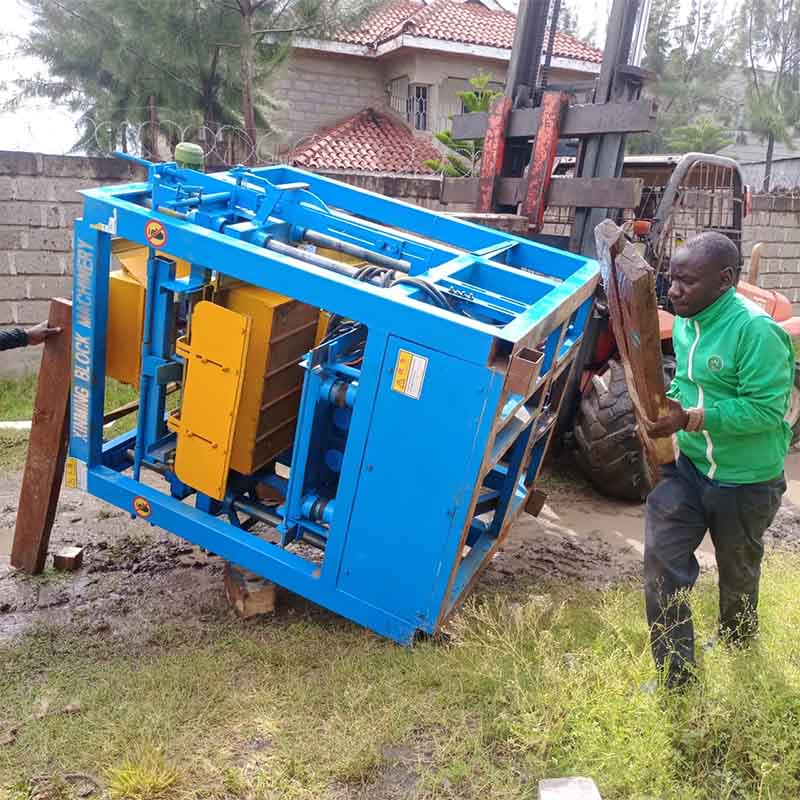
Image source Aiweibrickmachine
Ensuring Safety: Protocols for Operating Semi-Automatic Block Machines
Safety is paramount in the construction industry, and when it comes to operating semi-automatic block machines, the need for rigorous safety protocols cannot be overstated. These machines, while efficient and versatile, come with their own set of hazards. Operators, maintenance personnel, and all individuals working in the vicinity must adhere to strict safety guidelines to prevent accidents and ensure a secure working environment. In this comprehensive exploration, we delve into the critical safety protocols and best practices for operating semi-automatic block machines, emphasizing the importance of training, maintenance, and risk mitigation.
Section 1: Introduction to Semi-Automatic Block Machines
1.1 The Role of Semi-Automatic Block Machines
Semi-automatic block machines have revolutionized concrete block production, offering a balance between manual labor and full automation. They are capable of producing a wide range of blocks efficiently and consistently, but their operation requires careful attention to safety.
1.2 The Imperative of Safety
The construction industry is fraught with potential hazards, and operating semi-automatic block machines is no exception. Safety protocols are essential to protect the well-being of personnel and the longevity of equipment.
Section 2: Training and Skill Development
2.1 Operator Training
Operators must undergo rigorous training to understand the operation of semi-automatic block machines, safety procedures, and emergency protocols. This training should be ongoing to keep operators updated on best practices.
2.2 Maintenance Personnel Training
Maintenance personnel play a crucial role in ensuring machine safety. They should be trained to perform routine maintenance, identify potential issues, and carry out repairs safely.
Section 3: Machine-Specific Safety Features
3.1 Emergency Stop Buttons
Semi-automatic block machines are equipped with emergency stop buttons that allow operators to quickly halt machine operations in case of an emergency.
3.2 Guards and Barriers
Physical guards and barriers are placed around moving parts of the machine to prevent access during operation, reducing the risk of accidents.
3.3 Lockout/Tagout Procedures
Lockout/tagout procedures are implemented during maintenance to ensure that machines are de-energized and secured before maintenance work begins.
3.4 Safety Interlocks
Safety interlocks are electronic systems that ensure certain conditions are met before the machine can be operated, such as the closure of machine guards.
Section 4: Pre-Operation Safety Checks
4.1 Visual Inspections
Before starting the machine, operators should conduct visual inspections to check for loose bolts, damaged components, and any signs of wear or deterioration.
4.2 Material Handling
Proper material handling procedures must be followed to prevent injuries while loading raw materials into the machine.
4.3 Workspace Preparation
The workspace around the machine should be clear of obstructions, and designated walkways and work areas should be marked for safe movement.
Section 5: Operational Safety
5.1 Personal Protective Equipment (PPE)
Operators and personnel in the vicinity of the machine must wear appropriate PPE, including safety glasses, hearing protection, gloves, and steel-toed boots.
5.2 Safe Operation
Operators should adhere to safe operating practices, including keeping hands and clothing away from moving parts, avoiding reaching into the machine during operation, and following machine-specific guidelines.
5.3 Machine Controls
Operators must be familiar with machine controls, including emergency stop buttons, and be prepared to use them in case of an emergency.
5.4 Supervision
Supervisors should monitor machine operations to ensure that safety protocols are followed and intervene if any unsafe practices are observed.
Section 6: Emergency Response
6.1 Emergency Procedures
Clear and well-communicated emergency procedures should be in place, including protocols for machine malfunctions, fires, electrical failures, and injuries.
6.2 First Aid and Medical Assistance
A designated first aid station with trained personnel should be readily available, and access to medical assistance should be ensured in case of serious injuries.
Section 7: Maintenance Safety
7.1 Lockout/Tagout
Before performing maintenance or repairs, maintenance personnel should follow lockout/tagout procedures to de-energize and secure the machine.
7.2 Equipment Inspection
Maintenance personnel should conduct thorough inspections of the machine to identify and address wear, damage, or malfunctioning components.
7.3 Safe Maintenance Practices
Maintenance tasks should be carried out in a systematic and safe manner, with proper tools and equipment, and with a clear understanding of potential hazards.
Section 8: Risk Mitigation
8.1 Risk Assessment
Regular risk assessments should be conducted to identify and mitigate potential hazards associated with the operation of semi-automatic block machines.
8.2 Safety Culture
Fostering a safety culture within the workplace, where safety is a top priority and all employees are encouraged to report unsafe conditions, is crucial.
8.3 Continuous Improvement
Safety protocols should be reviewed and updated regularly to incorporate lessons learned from incidents and near-misses.
Section 9: Regulatory Compliance
9.1 Industry Standards
Adherence to industry-specific safety standards and regulations is essential to ensure that the operation of semi-automatic block machines is in compliance with legal requirements.
9.2 Regulatory Training
Personnel should be trained on relevant safety regulations and standards to ensure full compliance.
Section 10: Conclusion
Operating semi-automatic block machines can be a safe and efficient process when the right safety protocols are in place. Training, machine-specific safety features, pre-operation checks, operational safety practices, emergency response procedures, and maintenance safety all contribute to a secure working environment. Risk mitigation, a strong safety culture, and compliance with industry standards further enhance safety. By prioritizing safety, construction companies can protect their personnel, equipment, and reputation while contributing to a more secure and sustainable construction industry. Ultimately, the well-being of all those involved in the operation of semi-automatic block machines hinges on the implementation and adherence to rigorous safety protocols.
